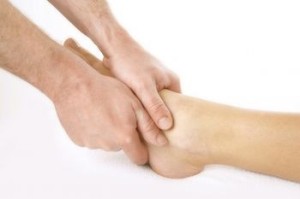Have you ever had your child wake up in the middle of the night with leg cramps? … It’s awful!!
 Growing pains are the most common cause of leg cramps in young children. Despite occurring in up to 36.9 % of children, our understanding of why it occurs still remains poor (Evans & Scutter, 2004).
Growing pains are the most common cause of leg cramps in young children. Despite occurring in up to 36.9 % of children, our understanding of why it occurs still remains poor (Evans & Scutter, 2004).
What Are the Possible Causes of Leg Cramps?
Muscle overuse, misalignment of the joints (such as knock-knees or flat-feet) and even psychological factors have all been suggested as playing a role, however, none of these theories have been conclusive (Evans, Scutter, Langb & Dansie 2006). What we do know is that recurrent pain negatively impacts physical, mental and schooling aspects of a child’s life and may even lead to physical and mental problems later on in adulthood (Alcantara & Davis 2010).
Growing pains are a significant cause of childhood discomfort and for the ease and comfort of all involved (both the distressed child and the weary, tired parents) the issue needs to be addressed and a suitable remedy found.
Some Facts About Leg Cramps & Growing Pains
- Growing pains most commonly occur in children aged 2-12, and disappear by puberty (Britt-MajWikström & Ekman 2009).
- The pain is generally present in both legs, most often in the late afternoon or at night, and often wakes the child from sleep.
- Importantly, there should be no signs of swelling, redness, trauma, limping or decreases in movement – if so, seek the advice of a primary health practitioner (Peterson 1986, as cited in Evans et al 2006).
A 2006 study conducted in South Australia found that growing pains generally occurred between one and three monthly intervals and there was no overall difference in amount of activity between children with and without growing pains. Children with growing pains were also found to be significantly heavier and in 69.8% of cases, they had a family history of growing pains in either a parent or sibling (Evans & Scutter, 2006).
What can be done to remedy leg cramps and growing pains?
In their South Australian study, Evans et al (2006) explain that health professionals often don’t have adequate ways to remedy leg cramps and growing pains, and that parents end up using pain relief techniques based on habit or anecdote, such as rubbing the child’s legs, using hot water bottles and giving them paracetamol.
In my book and previous discussions we have looked at the potential risks associated with seemingly harmless pain medication such as paracetamol being given to children.
So what other options then do parents have?
The best place to start is by considering the possible causes of these muscle cramps for your child.
- Let’s start with the feet – “Are their shoes too small or too worn?”
- Let’s think about the muscles – “Could your child be dehydrated and need to drink more water?” or “Is their diet not varied enough; do they have a magnesium deficiency?”
- Let’s think about nerve communication and spine function – “Is it possible they have fallen over and created nerve and joint irritation in their pelvis?” or “Have they been sitting too much or too awkwardly, creating spinal misalignments which are affecting the nerves?”
A recent case study found that when growing pains are linked to spine and nerve dysfunction, chiropractic care may be of benefit (Alcantara & Davis 2010).
In this study, two toddlers (a 2¾-yr-old girl and 3½-yr-old boy) were taken to the chiropractor with growing pains of several months duration. Medical care had thus far recommended offering Tylenol. In the chiropractic examination, spinal dysfunction (or vertebral subluxations) were detected in the lumbosacral spine of both children and chiropractic adjustments were made to help improve nerve function and spinal motion. After their first chiropractic adjustment, both mothers stated that their child did not wake at night with growing pains, and after completing a trial of care, both children’s initial complaints fully resolved.
It is important to remember the relationship that exists between the spine, pelvis and legs. These areas of the body are like a chain; nerve, joint or muscle dysfunction in any part of this chain can affect the other parts, and the nerves that extend from the lumbosacral region of the spine transmit signals between the legs and the brain. Any interruption to these signals can impair proper functioning of the body. Both children in the study above were found to have dysfunction in this lumbosacral region.
Instead of treating specific problems (such as growing pains), chiropractic aims to correct underlying or undetected nerve and spine dysfunction, helping the body to naturally work the way it should. In addition to looking at other factors that may influence growing pains such as nutrition, hydration and footwear, addressing possible nerve and spinal dysfunctions may help growing pains to rapidly resolve on their own.
It is nice to know that chiropractic can be used, especially for our little ones, as part of our overall approach to health.
For more information about the chiropractor’s role in improving your
children’s natural ability to self-heal, please see “Children & Chiropractic”
and Holistic Parenting“.
. . .
WRITTEN BY:
Jennifer Barham-Floreani
Bach. Chiropractic, Bach. App Clinical Science
Registered internationally, no longer practicing as a chiropractor in Australia.
. . .
Evans A.M., Scutter S.D., Langb M.G., Dansie B.R. 2006. “Growing pains” in young children: A study of the profile, experiences and quality of life issues of four to six year old children with recurrent leg pain. The Foot 16:120-124.




1 thought on “Growing Pains / Leg Cramps Remedy”
Pingback: Soulager Les Douleurs Des Poussées De Croissance | Remèdes de Grand-Mère